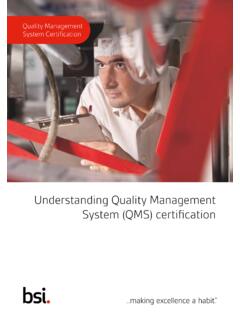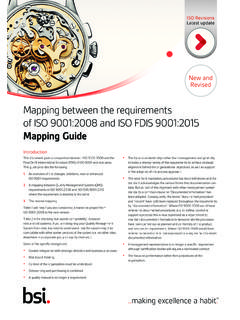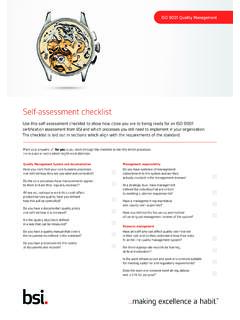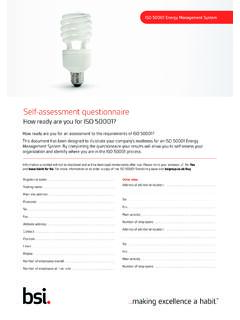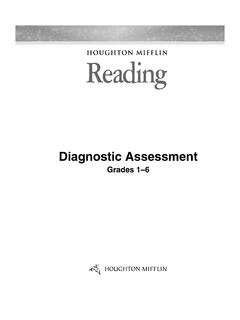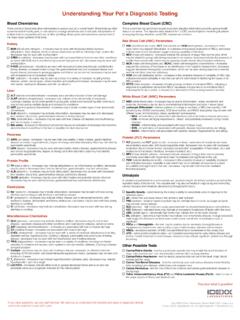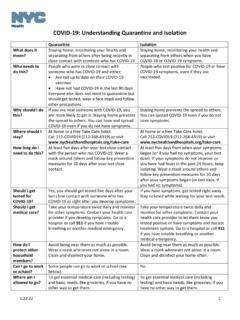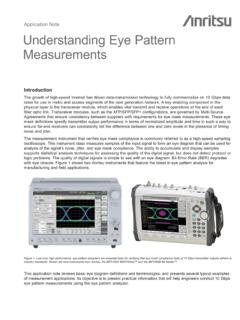Transcription of A guide to the In Vitro Diagnostic Directive
1 A guide to the In Vitr o Diagnostic DirectiveBSI: An In Vitr o diagnostics Notified excellence a BSI guide to the In Vitr o Diagnostic DirectiveIntroductionIn Vitro diagnostics (IVD) is an essential and fast growing part of the global healthcare system, as they add value to patients, medical professionals and the industry along with enhancing the well-being of the population as a purpose of the BSI IVD guide is to provide useful information to In Vitro Device Manufacturers and other interested parties seeking to place products on to the European Market. This requires a clear understanding of the In Vitro Diagnostic Directive (IVDD) 98/79/EC which sets the regulatory requirements for obtaining CE marking.
2 Information is also presented on how to determine if you require a Notified Body to assess conformity prior to affixing a CE mark. If you think you may need a Notified Body, whether your device ranges from simple to complex, BSI s in-house team of experts are here to assist you. We promise to deliver professional, fast and responsive services with the highest quality and most efficient reviews Aim of the In Vitro Diagnostic Directive (98/79/EC)The In Vitro Diagnostic Directive (IVDD) 98/79/EC was introduced in the later part of 1998 and compliance became mandatory on December 7, 2003. The Directive provides regulatory requirements that facilitate the free trade within the European Economic Area (EEA), which comprises the 27 European Union (EU) member states and Iceland, Liechtenstein and Norway as members of the European Free Trade Association (EFTA).
3 The IVDD specifically addresses the safety, quality and performance of In Vitro Diagnostic medical devices (IVDs). The aim of the Directive is to ensure that IVDs do not compromise the health and safety of patients, users and third parties and attain the performance levels specified by the manufacturer. The manufacturer is responsible for ensuring their products comply with the Essential Requirements of the Directive before affixing the CE marking and legally gaining access and free movement within the EEA. However, for some devices the use of a Notified Body may be required for conformity assessments before placing the device on the European is an In Vitro Medical Device?
4 IVDs are medical devices and accessories used to perform tests on samples, such as blood, urine, tissue, taken away from the human body to help detect infection, diagnose a medical condition, prevent disease or monitor drug first step is to determine if the product is a medical device as defined by the Directive . The In Vitro Device Directive Article 1, point 2b defines an IVD as any medical device which is a Reagent, Reagent Product Calibrator, Control Material Kit Instrument, Apparatus Equipment, SystemWhether used alone or in combination, intended by the manufacturer to be used in Vitro for the examination of specimen, including blood and tissue donations, derived from the human body, solely or principally for the purpose of providing information.
5 Concerning a physiological of pathological state of health or disease, or concerning a congenital abnormality, or to determine the safety and compatibility with potential recipients, or to monitor therapeutic include: HIV test kits Immunoassay analysers Blood gas analysers The calibrators and control materials used to verify the performance of the analysers Specimen receptacles and blood collection tubes Blood glucose meters and strips2 A guide to the In Vitro Diagnostic DirectiveIs a Notified Body Required?Annex II List AAnnex II List BSel f TestGeneralTests for Hormones, Cardiac Markers, Hematology and Clinical Chemistry TestsPregnancy, CholesterolHome TestsPregnancy, CholesterolHome TestsRubella, PSA,Self Test for Blood GlucoseIVDD Cla ssifi ca tionExa mplesNo Notified Body Required ManufacturerSelf DeclaresNoti fied Body RequiredReview of Design & Labeling fo r Lay User SuitabilityNoti fied Body RequiredAudit of Technical Docu mentati on& Quality Management SystemNoti fied Body RequiredDesign Dossier Review (I ncludi ng C ompli ance to th e CTS )
6 Audit of Quality Management Sy stemBatch Released by the Notifi ed BodyHIV, Hepati ti s ABO Blood Gr oupingAnnex II List AAnnex II List BSel f TestGeneralTests for Hormones, Cardia c Markers, Hematology and Clinical Chemistry T estsRubella, PSA,Self Test for Blood GlucoseNo Notified Body Required ManufacturerSelf DeclaresNoti fied Body RequiredReview of Design & Labeling fo r Lay User SuitabilityNoti fied Body RequiredAudit of Technical Docu mentati on& Quality Management SystemNoti fied Body RequiredDesign Dossier Review (I ncludi ng C ompli ance to th e CTS )Audit of Quality Management Sy stemBatch Released by the Notifi ed BodyHIV, Hepati ti s ABO Blood Gr oupingWho Does the Directive Apply To?
7 The Directive applies to all IVDs sold in the EEA regardless of where they are designed and manufactured. If the manufacturer is based outside the EEA you may still be responsible for ensuring your device meets the requirements of the you are a distributor and the device is not already CE marked or you change the intended purpose of a device, for example from point of care to self test or you add your own instructions for use or labelling you could become the manufacturer and therefore responsible for meeting the requirements of the you are not based in the European Union, you will be required to have an Authorised Representative based in the EU.
8 The Directive lists Essential Requirements to which all IVDs must comply before being placed on the market. These requirements address the design, production, labelling and instructions for use. Not all the Essential Requirements will apply to all devices; the manufacturer determines which are appropriate for their device according to the manufacturer s intended commonly demonstrate compliance using an Essential Requirement checklist, which considers each Essential Requirement and determines whether it is applicable. One way in which manufacturers can demonstrate that they have met the Essential Requirements is to comply with the relevant standards.
9 Harmonised standards, such as ISO 13485 for Quality Management Systems or ISO 14971 for Risk Management, have been written especially to help demonstrate compliance with the Directive . If you meet the requirements of these standards in full there is a presumption that you conform to the requirements of the Essential Require ments address the risk of the device including: Analytical & Diagnostic sensitivity, Analytical & Diagnostic specificity, Accuracy, Repeatability, Reproducibility. Classification and the Conformity Assessment RoutesThere are a number of ways you can demonstrate conformity with the Directive , these involve a choice of testing and quality assurance modules.
10 The choices available depend on the classification of the device. Appendix I describes the different routes Directive groups IVDs into four categories according to the perceived risk associated with the relative danger to public health and/or patient treatment by an IVD failing to perform as intended. The diagram below shows the classification and indicates where a Notified Body is II of the Directive contains an inclusive list of products which require certification by a third party called a Notified Body. Only the devices specifically listed in Annex II require a Notified Body, for example PSA is the only cancer marker in List guide to the In Vitro Diagnostic Directive 3 General IVDsGeneral devices include all IVDs other than those covered by Annex II and IVDs for self-testing.
